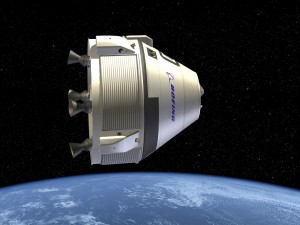
Today at 4pm EDT from Kennedy Space Center NASA announced the winners of the Commercial Crew Transportation Capability (CCtCap) contracts.
And the winners are:

Boeing – The CST-100 capsule seen to the right has been awarded $4.2 billion of the money. Over the next three years Boeing will have to complete a number of milestones below to prove that the CST-100 capsule can indeed deliver crew to the ISS.
While the CST-100, according to Boeing, can be launched on multiple rockets they have selected to use the Atlas V as the launch vehicle.
This will bring Boeing’s total under the Commercial Crew Development program to $4.77 billion.

SpaceX – The Dragon V2 again seen on the right has also been awarded a contract of $2.6 billion allowing NASA to have a two options for the CCtCap process.
At the time of writing SpaceX have not completed their pad or launch abort tests from the CCiCap contract, however they are scheduled to be completed in the next six months and there should be no reason that SpaceX couldn’t be ready before 2017.
This will bring SpaceX’s total under the Commercial Crew Development program $3.11 billion
Each company will have to pass five certification milestones as well as a number of others that they themselves have selected, payment will be based on the different milestones. We will bring you news of these milestones once the information has been been made available.
Under the contracts awarded today both companies will perform one demo flight each and a maximum of six crewed missions to the station carrying four crew members each time, they also include some money towards additional studies. With the introduction of the Dragon V2 and CST-100 NASA have also announced that the space station will move from a six member crew to seven members allow more research to be performed.
The award amounts are based on the paperwork that was submitted during the process by each company and both have to meet the same goals laid out by NASA. Basically SpaceX will be achieving the same goals for 62% the cost that Boeing will.
In summary this is what we hoped would happen, two competitors have been selected and the next few years are going to be exciting for US manned spaceflight, we are another step closer to returning crewed flight to US soil and despite the fact that one of the competitors is still reliant on Russian engines to get into orbit that may change too as news of a partnership between ULA and Blue Origin to be announced tomorrow could see the RD-180 replaced, we will bring new of that announcement as soon as we have it.
At present we have no news on what will happen to the Dream Chaser program at SNC, when we have further information it will be made available here.
Leave a Reply